Introduction |
Formats |
Printings |
Dies |
Paper |
Straight Edges |
Coils |
Fakes |
Forgeries |
Terminology |
Varieties |
Cancellations |
Rates |
Bibliography
Forged Overprints on the Admirals
This page continues our examination of Admiral stamps that have been altered to make them appear to be something they are not. It looks at two overprints found on the Admirals, both of which have been forged.
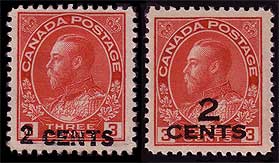
When postage rates were reduced due to the removal of the War Tax on 1 July 1926, the Post Office was stuck with millions of 3¢ stamps that were already printed. It was decided to revalue the stamps to 2¢ by overprinting them. 140,000 panes of 100 were given to the King's Printer who overprinted the stamps using a one-line overprint. However, the results were unsatisfactory so all were destroyed except for 500 panes that were placed on sale at the Philatelic Agency sometime in October 1926.
The Canadian Bank Note Company was next to try overprinting the stamps. So that their work could be distinguished from that of the King's Printer, a two-line overprint was used on about 1,100 post office panes of 100. Apparently the work was again unsatisfactory and only 808 panes were placed on sale at the Philatelic Agency in November 1926.
Because the overprinted stamps were available only through the Philatelic Agency, most of them were likely sold to stamp collectors who saved them as mint stamps. Used overprinted stamps exist, but not in large numbers.
1. The One-Line Overprint
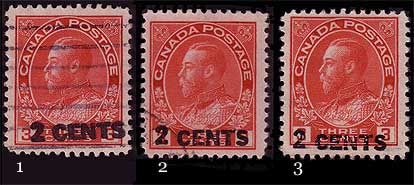
Illustrated above are three copies of the 3¢ carmine Admiral with the one-line overprint. The stamps are numbered from 1 to 3. Below are enlarged photographs of the three overprints, also numbered from 1 to 3. Most of the 3¢ stamps overprinted with the one-line overprint are Die I. Die II stamps exist with this overprint, but are very scarce. Any Die II stamp with the one-line overprint should be carefully examined for a forged overprint.
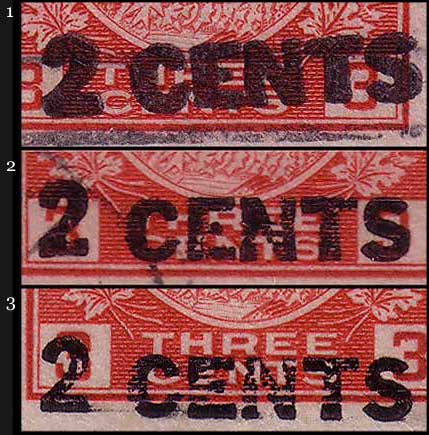
1.1 Stamp #1, Die I, Used
That there is something quite wrong with this overprint is obvious. The overprint is longer than normal, and the letters are thicker. Not visible in the photograph is the dullness of the black ink used to print this overprint. The ink of a genuine overprint is somewhat shiny when viewed at an oblique angle. The fact that this overprint is printed at a slight angle does not automatically make it suspect, but in combination with the other characteristics already mentioned, it is one more piece of evidence that this overprint is not genuine.
1.2 Stamp #2, Die II, Used
Note the characteristics of Die II on this stamp. If the overprint is genuine, this is a very rare stamp. The ink used to print this overprint is somewhat shiny just like that of a genuine overprint. The letters of the overprint are a bit thicker than overprint on stamp #3, but this could be due to over-inking. The ends of some of the letters are a bit rounded - such as the top end of the 2, the top end of the C, and both ends of the S - but this too, could be due to over-inking. Other letters such as the E, N, and T have fairly sharp corners. The overprint is the exact length of the overprint on stamp #3. That the stamp is used does not automatically make the overprint suspect, but it certainly should to be considered, especially if the stamp is Die II. At this point, I do not know if this is a genuine overprint or not, but am leaning towards a forgery.
1.3 Stamp #3, Die I, Mint
The ink used to print this overprint is the somewhat shiny ink of genuine overprints. The overprint does not exhibit any characteristics that would make it suspect, and I believe it is a genuine one-line overprint.
2. The Two-Line Overprint
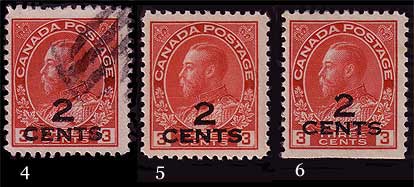
Illustrated above are three copies of the 3¢ carmine Admiral with the two-line overprint. The stamps are numbered from 4 to 6. Below are enlarged photographs of the three overprints, also numbered from 4 to 6. It is generally thought that all of the 3¢ stamps overprinted with the two-line overprint are Die I. Therefore, any Die II stamp with the two-line overprint most likely has a forged overprint.
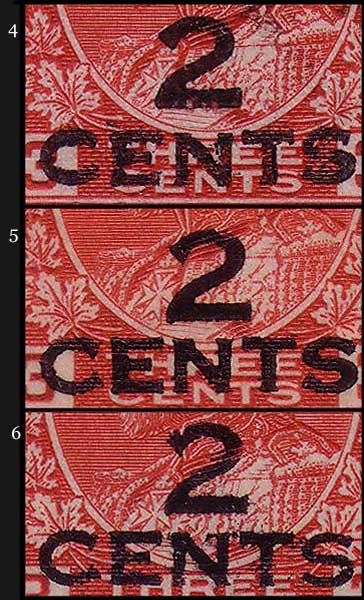
2.1 Stamp #4, Die II, Used
The characteristics of Die II are obvious on this stamp because they are not covered by the overprint or the cancellation. The alignment of the 2 over the letters of CENTS is different from the overprints on stamps #5 and #6. However, Marler says this alignment varies on the genuine overprints, and this particular overprint seems to be within the limits described in his book. The top right end of the letter S does not come out as far as that on the other two overprints. Not visible in the photograph is the dullness of the black ink used to print this overprint. The ink of a genuine overprint is somewhat shiny when viewed at an oblique angle. Because of the dull black ink and the Die II stamp, I believe this overprint is not genuine. It is a dangerous forgery in that it so closely resembles a genuine overprint.
The two-line overprint forgery described by Marler (The Admiral Issue of Canada, pp. 552-553) is probably the same as this one. He describes going through a lot of several hundred used stamps, all of which had the forged overprint.
2.2 Stamps #5 and #6, Die I, Mint
The ink used to print these overprints is the somewhat shiny ink of genuine overprints. These overprints do not exhibit any characteristics that would make them suspect, and I believe they are both genuine two-line overprints. Some of the letters on stamp #5 seem to be thicker than the letters on stamp #6, but this is likely due to over-inking.
3. Other Forged Overprints on the Admirals
The WAR TAX overprints on the 5¢, 20¢, and 50¢ Admirals have been forged. I had one many years ago that I had expertized because I was suspicious of the overprint. The certificate came back saying the overprint was not genuine, so I sent the stamp back to the dealer and got a refund. Since then, I have not examined enough WAR TAX overprints to write about them at this time.
Introduction |
Formats |
Printings |
Dies |
Paper |
Straight Edges |
Coils |
Fakes |
Forgeries |
Terminology |
Varieties |
Cancellations |
Rates |
Bibliography